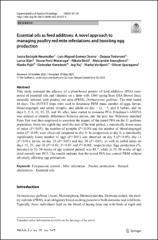Essential oils as feed additives: A novel approach to managing poultry red mite infestations and boosting egg production
| dc.contributor.author | Bošnjak-Neumüller, Jasna | |
| dc.contributor.author | Gomez Osorio, Luis-Miguel | |
| dc.contributor.author | Todorović, Dajana | |
| dc.contributor.author | Ilijin, Larisa | |
| dc.contributor.author | Perić-Mataruga, Vesna | |
| dc.contributor.author | Delić, Nikola | |
| dc.contributor.author | Stanojković, Aleksandar | |
| dc.contributor.author | Pajić, Marko | |
| dc.contributor.author | Knežević, Slobodan | |
| dc.contributor.author | Raj, Jog | |
| dc.contributor.author | Vasiljević, Marko | |
| dc.contributor.author | Sparagano, Olivier | |
| dc.date.accessioned | 2025-07-16T11:48:04Z | |
| dc.date.available | 2025-07-16T11:48:04Z | |
| dc.date.issued | 2025 | |
| dc.identifier.issn | 0168-8162 | |
| dc.identifier.uri | https://repo.niv.ns.ac.rs/xmlui/handle/123456789/1000 | |
| dc.description.abstract | This study assessed the efficacy of a plant-based premix of feed additives (PFA) composed of essential oils and vitamins on a farm with 1560 laying hens (ISA Brown line), naturally infested with poultry red mite (PRM), Dermanyssus gallinae. The trial lasted 44 days. The AVIVET traps were used to determine PRM mass, number of eggs, larvae, blood-engorged and unfed nymphs, and adults on day − 12, − 5, and 0 before, and on days 2, 5, 8, 11, 15, 23, and 30, after, hens started to consume PFA. Friedman’s ANOVA was utilised to identify differences between means, and the post hoc Wilcoxon matched Pairs Test was then employed to ascertain the impact of the tested PFA on the D. gallinae population. From the eighth day until the end of the trial period, a statistically lower mass of mites (P < 0.05), the number of nymphs (P < 0.05) and the number of blood-engorged mites (P < 0.05) were observed compared to day 0. In comparison to day 0, a statistically significantly lower number of eggs (P < 0.01) was observed on day 5 (P < 0.05), day 11 (P < 0.01), larvae on day 23 (P < 0.05) and day 30 (P < 0.01), as well as unfed mites on days 15, 23, and 30 (P < 0.01, P < 0.01 and P < 0.001, respectively). Egg production (%, hen-day) in 52–54 weeks of age (control period) was 88.7, while in 55–58 weeks of age (trial period) was 89.5. The results indicate that the tested PFA can control PRM without adversely affecting egg production. | en_US |
| dc.description.sponsorship | The research was carried out under contracts 451-03-136/2025-03/200007 (D.T., L.I., and V.P.M.) (Ministry of Science, Technological Development and Innovation of the Republic of Serbia) and financially supported by the company PATENT CO. DOO (Serbia). | en_US |
| dc.language.iso | en | en_US |
| dc.source | Experimental and Applied Acarology | en_US |
| dc.subject | Ectoparasite control | en_US |
| dc.subject | Mite infestation | en_US |
| dc.subject | Poultry production | en_US |
| dc.subject | Natural alternatives | en_US |
| dc.subject | Essential oils | en_US |
| dc.title | Essential oils as feed additives: A novel approach to managing poultry red mite infestations and boosting egg production | en_US |
| dc.type | Article | en_US |
| dc.identifier.doi | 10.1007/s10493-025-01035-5 | |
| dc.citation.volume | 95 | en_US |
| dc.citation.issue | 10 | en_US |
| dc.citation.spage | 10 | en_US |
| dc.citation.rank | M21 | en_US |
| dc.type.version | published | en_US |
Files in this item
This item appears in the following Collection(s)
-
Naučni radovi
Radovi objavljeni u naučnim časopisima

